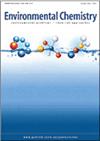Different characteristics and source contributions to aerosol aminiums over a coastal city and adjacent marginal seas
IF 2.3
4区 环境科学与生态学
Q3 CHEMISTRY, ANALYTICAL
引用次数: 1
Abstract
Environmental context Amines in the atmosphere play important roles in atmospheric chemistry and have potential climate effects. We characterise the concentrations, size distributions and chemical pathways of aerosol aminiums over a coastal city and marginal seas, and estimated the contribution of marine biogenic sources. This study can facilitate our understanding about the interactions between human activities, biogenic emissions and the atmospheric environment. Abstract Atmospheric amines are gaining more and more attention in the field of atmospheric chemistry owing to their important roles in new particle formation and growth. In this study, aerosol aminiums over a coastal city (Shanghai) and the Yellow and East China seas (YECS) were characterised. The concentrations of NH4+, dimethylaminium (DMAH+) and trimethylaminium + diethylaminium (TMDEAH+) over Shanghai were all found to be higher in the winter of 2018 than in the summer of 2019, suggesting their non-negligible terrestrial contributions. DMAH+ and TMDEAH+ concentrations over the YECS in summer were closely correlated and linked to surface phytoplankton biomass, implying that marine biogenic sources might be a predominant contributor to aminiums at this time. Aminiums over Shanghai generally showed a bimodal distribution with a main peak in droplet mode and a secondary peak in condensation mode, suggesting the notable contribution of aqueous-phase or heterogeneous reaction to the formation of aminiums. In contrast, aminiums over the YECS often showed a unimodal distribution, which may be caused by the competition between amines and NH3 for reaction with acidic compounds. We estimated the contributions of marine biogenic sources, ~73.6 % to DMAH+ and 80.1 % to TMDEAH+ over the YECS, using methanesulfonate/non-sea-salt SO42– as an indicator. Our results suggest that marine biogenic emission of amines from China’s marginal seas may have a potential impact on coastal cities, and this source should be considered in modelling new particle formation and air quality in coastal areas.沿海城市和邻近边缘海域气溶胶胺的不同特征和来源贡献
大气中的胺类物质在大气化学中起着重要作用,具有潜在的气候效应。我们描述了沿海城市和边缘海域气溶胶胺的浓度、大小分布和化学途径,并估计了海洋生物源的贡献。这项研究有助于我们了解人类活动、生物排放与大气环境之间的相互作用。摘要大气胺类化合物由于在新粒子的形成和生长中起着重要的作用,在大气化学领域受到越来越多的关注。在这项研究中,气溶胶胺在沿海城市(上海)和黄海和东海(yess)的特征。2018年冬季,上海上空NH4+、二甲胺(DMAH+)和三甲胺+二乙胺(TMDEAH+)浓度均高于2019年夏季,表明它们的陆源贡献不可忽略。夏季海域DMAH+和TMDEAH+浓度与海面浮游植物生物量密切相关,表明海洋生物源可能是这一时期氨的主要来源。上海地区的氨总体上呈现出以液滴模式为主峰、冷凝模式为次峰的双峰分布,表明水相或非均相反应对氨的形成有显著贡献。相比之下,在yec上的胺通常呈现单峰分布,这可能是由于胺和NH3与酸性化合物反应时相互竞争造成的。以甲烷磺酸盐/非海盐SO42 -为指标,我们估计了海洋生物源对DMAH+的贡献为73.6%,对TMDEAH+的贡献为80.1%。我们的研究结果表明,来自中国边缘海域的海洋生物排放胺可能对沿海城市产生潜在影响,在模拟沿海地区新颗粒形成和空气质量时应考虑这一来源。
本文章由计算机程序翻译,如有差异,请以英文原文为准。
求助全文
约1分钟内获得全文
求助全文
来源期刊

Environmental Chemistry
环境科学-分析化学
CiteScore
4.50
自引率
0.00%
发文量
0
审稿时长
2.7 months
期刊介绍:
Environmental Chemistry publishes manuscripts addressing the chemistry of the environment (air, water, earth, and biota), including the behaviour and impacts of contaminants and other anthropogenic disturbances. The scope encompasses atmospheric chemistry, geochemistry and biogeochemistry, climate change, marine and freshwater chemistry, polar chemistry, fire chemistry, soil and sediment chemistry, and chemical aspects of ecotoxicology. Papers that take an interdisciplinary approach, while advancing our understanding of the linkages between chemistry and physical or biological processes, are particularly encouraged.
While focusing on the publication of important original research and timely reviews, the journal also publishes essays and opinion pieces on issues of importance to environmental scientists, such as policy and funding.
Papers should be written in a style that is accessible to those outside the field, as the readership will include - in addition to chemists - biologists, toxicologists, soil scientists, and workers from government and industrial institutions. All manuscripts are rigorously peer-reviewed and professionally copy-edited.
Environmental Chemistry is published with the endorsement of the Commonwealth Scientific and Industrial Research Organisation (CSIRO) and the Australian Academy of Science.
 求助内容:
求助内容: 应助结果提醒方式:
应助结果提醒方式:


